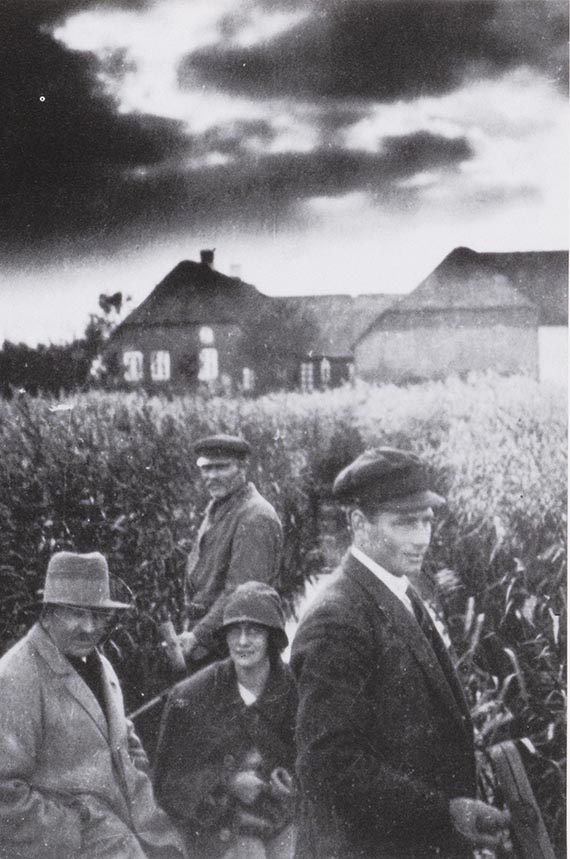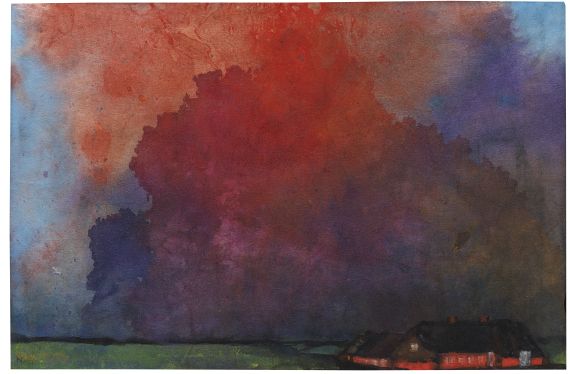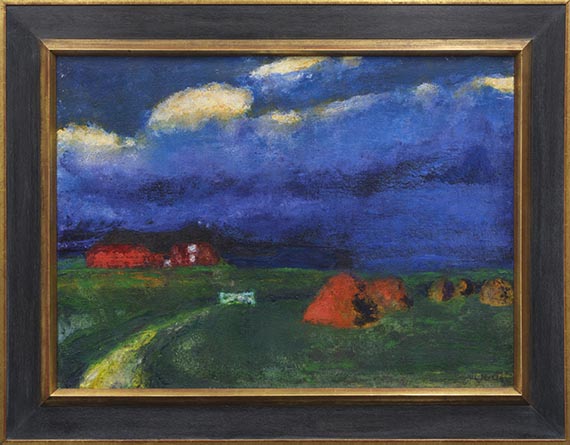Image du cadre
Autre image
32
Emil Nolde
Landschaft mit Seebüllhof, 1930.
Oil on canvas
Estimation:
€ 600,000 / $ 660,000 Résultat:
€ 914,400 / $ 1,005,840 ( frais d'adjudication compris)
Landschaft mit Seebüllhof. 1930.
Oil on canvas.
Signed in the lower right. Signed and titled on the stretcher. 74 74 x 101 cm (29.1 x 39.7 in). [JS].
• Nolde at his best: a vibrant marsh painting full of atmosphere, a painting tha unites expressive colors and superb technique.
• He captured the brief moment of the evening sunlight magically illuminating the neighboring Seebüll farmstead.
• Blue is a key feature in Nolde's painting; he displays its wide range in our work: indigo, ultramarine, Prussian blue, and Paris blue, among others.
• The view from Seebüll, which Nolde preferred to capture in watercolor but rarely in oil.
• Excellent provenance: from the possession of his architect and part of the important Berthold and Else Beitz Collection, Essen, for over 50 years.
• Painted in the same color palette: “Vera” is also offered in this auction and comes from the same private collection..
The work is registered in the artist's inventory list as “1930 Landschaft mit Seebüllhof”.
PROVENANCE: Georg Wilhelm Rieve (1888–1966) Collection, Flensburg (from 1936).
Ingeborg Redlefsen née Rieve, Flensburg (from the above, until 1969).
Wilhelm Großhennig, Düsseldorf (1970).
Berthold and Else Beitz Collection, Essen (presumably acquired from the above).
Family-owned ever since.
EXHIBITION: Kunsthütte Chemnitz, presumably: Der deutsche Norden (Barlach, Nolde, Rohlfs), January/February 1932 (with the stamped label on the reverse).
Emil Nolde, Kunsthalle, Kiel, July 10 - Aug. 17, 1947, no. 3 (without cat.).
Emil Nolde, Kunsthalle, Kiel, December 9, 1956 - January 13, 1957, cat. no. 30.
Emil Nolde, Städtisches Museum, Flensburg, January 8 - February 29, 1967, cat. no. 4.
Freunde des Museums sammeln, Museum Folkwang, Essen, 1972, cat. no. 52 (illustrated) Pommersches Landesmuseum, Greifswald (2015-2024, permanent loan).
LITERATURE: Martin Urban, Emil Nolde. Catalogue Raisonné of Paintings, vol. II (1915-1951), Munich 1990, no. 1095 (illustrated)
--
Margret Heuser, Ein Leben mit der Kunst. Wilhelm Großhennig, Düsseldorf 1986, p. 51 (illustrated).
Emil Nolde, Reisen, Ächtung, Befreiung: 1919-1946, Cologne 1978, p. 9
Oil on canvas.
Signed in the lower right. Signed and titled on the stretcher. 74 74 x 101 cm (29.1 x 39.7 in). [JS].
• Nolde at his best: a vibrant marsh painting full of atmosphere, a painting tha unites expressive colors and superb technique.
• He captured the brief moment of the evening sunlight magically illuminating the neighboring Seebüll farmstead.
• Blue is a key feature in Nolde's painting; he displays its wide range in our work: indigo, ultramarine, Prussian blue, and Paris blue, among others.
• The view from Seebüll, which Nolde preferred to capture in watercolor but rarely in oil.
• Excellent provenance: from the possession of his architect and part of the important Berthold and Else Beitz Collection, Essen, for over 50 years.
• Painted in the same color palette: “Vera” is also offered in this auction and comes from the same private collection..
The work is registered in the artist's inventory list as “1930 Landschaft mit Seebüllhof”.
PROVENANCE: Georg Wilhelm Rieve (1888–1966) Collection, Flensburg (from 1936).
Ingeborg Redlefsen née Rieve, Flensburg (from the above, until 1969).
Wilhelm Großhennig, Düsseldorf (1970).
Berthold and Else Beitz Collection, Essen (presumably acquired from the above).
Family-owned ever since.
EXHIBITION: Kunsthütte Chemnitz, presumably: Der deutsche Norden (Barlach, Nolde, Rohlfs), January/February 1932 (with the stamped label on the reverse).
Emil Nolde, Kunsthalle, Kiel, July 10 - Aug. 17, 1947, no. 3 (without cat.).
Emil Nolde, Kunsthalle, Kiel, December 9, 1956 - January 13, 1957, cat. no. 30.
Emil Nolde, Städtisches Museum, Flensburg, January 8 - February 29, 1967, cat. no. 4.
Freunde des Museums sammeln, Museum Folkwang, Essen, 1972, cat. no. 52 (illustrated) Pommersches Landesmuseum, Greifswald (2015-2024, permanent loan).
LITERATURE: Martin Urban, Emil Nolde. Catalogue Raisonné of Paintings, vol. II (1915-1951), Munich 1990, no. 1095 (illustrated)
--
Margret Heuser, Ein Leben mit der Kunst. Wilhelm Großhennig, Düsseldorf 1986, p. 51 (illustrated).
Emil Nolde, Reisen, Ächtung, Befreiung: 1919-1946, Cologne 1978, p. 9
Land between the seas
For Emil Nolde, this land between the seas is enough to sustain an artist's life. A life in harmony with nature, marked by the changing seasons and the course of the day, as well as by the vicissitudes of the weather. It is the landscape of Nolde's childhood, where he would settle with his wife Ada and make passionate paintings like this marsh landscape with a view of the farmstead 'Seebüllhof' in the light of the setting sun, with its glowing brick façade, the reddish evening light on the haystacks of the harvested fens. The young couple married in 1902 and lived in Berlin and on the island of Als. In 1916, they moved to a farmhouse in Utenwarf near the coast of the North Sea. Major landscape modifications, such as the construction of dikes and drainage systems, drove the Noldes away from there. In 1926, they first purchased the farm Seebüllhof to build the studio house on the property. “We wanted to call it Seebüll. We called the associated farm Seebüllhof.” (in: Ada and Emil Nolde, Festschrift 1957, p. 25)

This piece of land met his expectations of a landscape in harmony with nature, sparsely populated and wide open, with many birds and dense reed beds crisscrossed by narrow canals. As Nolde said in retrospect, it was a decision from the heart: “On long walks and trips along the west coast of Schleswig-Holstein and around Hamburg, we had looked for a house or a place. We found nothing. [..] Only when we stood in amazement one afternoon on the high, empty mound in Peter Jensen's district, and a young horse galloped around us and the floating clouds were reflected by the water, so magnificent that we looked at each other understandingly, and my Ada said, 'This is our place!' I agreed with her, and we bought the property without further ado.” (Quoted from: Emil Nolde, Reisen, Ächtung, Befreiung, 1978, pp. 80/81)

Romanticism and color
Nolde felt nature in the spirit of Romanticism, like Caspar David Friedrich. However, in contrast to the 'inventor' of the Romantic landscape, which he ultimately 'assembled' into his vision of landscape using his sketches of impressions of nature, Nolde painted not only the phenomenon of the vast land but also weather phenomena such as the floating clouds in the sky. He found colors to match the times of day, conveying the artist's deep connection to this region. In the present work, he lets the last rays of the setting sun reflect on the moist edges of the clouds. Like music, the melodious tones of the colors address us directly, allowing us to share a moment of joy from almost 100 years ago. Blue always stands out in contrast to burnt red and deep green, a vital characteristic that Nolde showcases in all its shades: indigo, ultramarine, Prussian blue, and Paris blue.
Nolde could rely on this strength and ability in colors; they became the medium of his artistic identity. From the barren landscape of the north constantly exposed to the changing play of light and weather, Nolde wrests those atmospheric works that make up a large part of his entire pictorial oeuvre, such as the many watercolors. At the same time, there are only very, very few paintings. The high sky over a plain, in which every elevation seems momentous, is the core motif of this wonderfully composed painting. The threatening drama of the moving clouds lies over the nature of Nolde's intensely colorful home like a thick blanket. “There are people who absolutely cannot understand why we, who could have it any other way, would want to live in this flat, 'boring' land, where there are no forests and no hills or mountains, and where there are not even trees on the banks of the small canals. That is probably how all the usual travelers who pass through tend to think. – Our landscape is modest, far from anything intoxicating or lush, we know that. However, it gives the intimate observer, for his love of it, an infinite amount of quiet, intimate beauty, austere grandeur, and even a wild and stormy life,” said Emil Nolde retrospectively. (Emil Nolde, Reisen, Ächtung, Befreiung: 1919-1946, Cologne 1978, p. 9). Each of his watercolors and paintings that pay homage to this stretch of land between the seas in the far north also tells of his deeply felt connection to a home that he shared with Ada.
Excellent provenance
This extraordinary marsh landscape changed hands in 1936, leaving the studio and entering the property of Georg Rieve. Rieve, an architect with an office in Flensburg, was a close friend of Nolde and supported the artist in planning and constructing the house and studio in Seebüll in the late 1920s and early 1930s. After Nolde died in 1956, Rieve was one of the founding members of the board of trustees that took care of the artist's estate. Georg Rieve died in 1966; the painting “Seebüllhof” passed into the ownership of Ingeborg Redlefsen, who in turn asked the Galerie Wilhelm Grosshennig in Düsseldorf to broker a sale in 1969. Since the 1970s, the painting “Seebüllhof” has been part of the renowned Berthold and Else Beitz Collection, Essen. [MvL]
For Emil Nolde, this land between the seas is enough to sustain an artist's life. A life in harmony with nature, marked by the changing seasons and the course of the day, as well as by the vicissitudes of the weather. It is the landscape of Nolde's childhood, where he would settle with his wife Ada and make passionate paintings like this marsh landscape with a view of the farmstead 'Seebüllhof' in the light of the setting sun, with its glowing brick façade, the reddish evening light on the haystacks of the harvested fens. The young couple married in 1902 and lived in Berlin and on the island of Als. In 1916, they moved to a farmhouse in Utenwarf near the coast of the North Sea. Major landscape modifications, such as the construction of dikes and drainage systems, drove the Noldes away from there. In 1926, they first purchased the farm Seebüllhof to build the studio house on the property. “We wanted to call it Seebüll. We called the associated farm Seebüllhof.” (in: Ada and Emil Nolde, Festschrift 1957, p. 25)

Emil Nolde and Ada with two farm labourers in a boat at Seebüll farm, around 1930.
© 2024 Stiftung Seebüll Ada und Emil Nolde
© 2024 Stiftung Seebüll Ada und Emil Nolde
This piece of land met his expectations of a landscape in harmony with nature, sparsely populated and wide open, with many birds and dense reed beds crisscrossed by narrow canals. As Nolde said in retrospect, it was a decision from the heart: “On long walks and trips along the west coast of Schleswig-Holstein and around Hamburg, we had looked for a house or a place. We found nothing. [..] Only when we stood in amazement one afternoon on the high, empty mound in Peter Jensen's district, and a young horse galloped around us and the floating clouds were reflected by the water, so magnificent that we looked at each other understandingly, and my Ada said, 'This is our place!' I agreed with her, and we bought the property without further ado.” (Quoted from: Emil Nolde, Reisen, Ächtung, Befreiung, 1978, pp. 80/81)

Emil Nolde, Bauernhof und Gewitterwolken, around 1935, watercolor, private collection.
© 2024 Stiftung Seebüll Ada und Emil Nolde
© 2024 Stiftung Seebüll Ada und Emil Nolde
Romanticism and color
Nolde felt nature in the spirit of Romanticism, like Caspar David Friedrich. However, in contrast to the 'inventor' of the Romantic landscape, which he ultimately 'assembled' into his vision of landscape using his sketches of impressions of nature, Nolde painted not only the phenomenon of the vast land but also weather phenomena such as the floating clouds in the sky. He found colors to match the times of day, conveying the artist's deep connection to this region. In the present work, he lets the last rays of the setting sun reflect on the moist edges of the clouds. Like music, the melodious tones of the colors address us directly, allowing us to share a moment of joy from almost 100 years ago. Blue always stands out in contrast to burnt red and deep green, a vital characteristic that Nolde showcases in all its shades: indigo, ultramarine, Prussian blue, and Paris blue.
Nolde could rely on this strength and ability in colors; they became the medium of his artistic identity. From the barren landscape of the north constantly exposed to the changing play of light and weather, Nolde wrests those atmospheric works that make up a large part of his entire pictorial oeuvre, such as the many watercolors. At the same time, there are only very, very few paintings. The high sky over a plain, in which every elevation seems momentous, is the core motif of this wonderfully composed painting. The threatening drama of the moving clouds lies over the nature of Nolde's intensely colorful home like a thick blanket. “There are people who absolutely cannot understand why we, who could have it any other way, would want to live in this flat, 'boring' land, where there are no forests and no hills or mountains, and where there are not even trees on the banks of the small canals. That is probably how all the usual travelers who pass through tend to think. – Our landscape is modest, far from anything intoxicating or lush, we know that. However, it gives the intimate observer, for his love of it, an infinite amount of quiet, intimate beauty, austere grandeur, and even a wild and stormy life,” said Emil Nolde retrospectively. (Emil Nolde, Reisen, Ächtung, Befreiung: 1919-1946, Cologne 1978, p. 9). Each of his watercolors and paintings that pay homage to this stretch of land between the seas in the far north also tells of his deeply felt connection to a home that he shared with Ada.
Excellent provenance
This extraordinary marsh landscape changed hands in 1936, leaving the studio and entering the property of Georg Rieve. Rieve, an architect with an office in Flensburg, was a close friend of Nolde and supported the artist in planning and constructing the house and studio in Seebüll in the late 1920s and early 1930s. After Nolde died in 1956, Rieve was one of the founding members of the board of trustees that took care of the artist's estate. Georg Rieve died in 1966; the painting “Seebüllhof” passed into the ownership of Ingeborg Redlefsen, who in turn asked the Galerie Wilhelm Grosshennig in Düsseldorf to broker a sale in 1969. Since the 1970s, the painting “Seebüllhof” has been part of the renowned Berthold and Else Beitz Collection, Essen. [MvL]
32
Emil Nolde
Landschaft mit Seebüllhof, 1930.
Oil on canvas
Estimation:
€ 600,000 / $ 660,000 Résultat:
€ 914,400 / $ 1,005,840 ( frais d'adjudication compris)




 Lot 32
Lot 32 